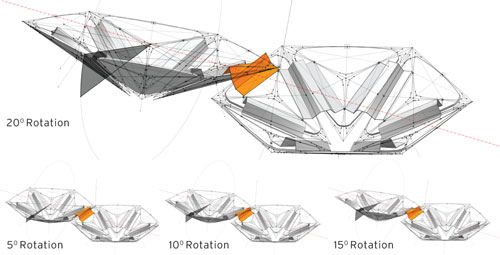When the Whole Is Greater Than the Sum of Its Parts
Belzberg's bold ceiling design addressed both challenges, and then some. Descending from the ceiling of the Conga Room's entry lobby, the "tornado," a 20-foot-tall element, pierces through the floor slab below it to act as a beacon. The diamond-shaped panels-inspired by the pattern of footsteps in the rumba-hang like a chandelier beside a curving staircase that carries guests up to the second floor. While this glowing, lower portion of the tornado is made up of acrylic panels that are illuminated by the light source behind it, the panels of the tornado's upper portion, and all remaining ceiling panels, are made of 1/2-inch thick plywood coated with white intumescent paint to reflect light, an inexpensive material that doubles as an acoustic treatment.
 |
|
|
The ceiling's bold design lures visitors up a stairwell to the second-floor club (above). Light fixtures and sprinkler heads are hidden within the center of the ceiling's flower shapes (left). The straps used to tie each flower to the next must withstand a certain tolerance of rotation (below). Photos: © Benny Chan |
 |
|
Â
In order to optimize sound absorption and vibration, the architects continually tweaked the overall look and curvature of the ceiling by focusing on the individual elements. "The ceiling design was always aesthetically driven," says Andrew Atwood, the project manager for the ceiling millwork, who worked closely with acoustical engineer Martin Newson during the nine-month design process. The diamondshaped panels of the tornado and entry sequence-many of which are unique-morph into "flowers" over the dance floor, where acoustical concerns are greatest. While there are only three panel shapes in this main part of the ceiling, the flowers vary greatly according to the arrangement of their petals, and the angle at which the petals are hung. These variables allow the ceiling's acoustics to be controlled based on density and porosity. Using the acoustical-simulation application in Ecotect, a building design and environmental analysis tool by Autodesk, they were able to calibrate the different ceiling porosities and locate zones that needed adjusting to enhance acoustics. The quantitative data extracted from Ecotect informed a sophisticated parametric model. Those parameters were plugged into a series of scripts with Excel spreadsheets, and finally into a digital model and fabrication drawings using Rhino. "When we worked on Patina in 2003, we really challenged digital fabrication," Belzberg recalls. "Since then, we've fallen in love with the process."










